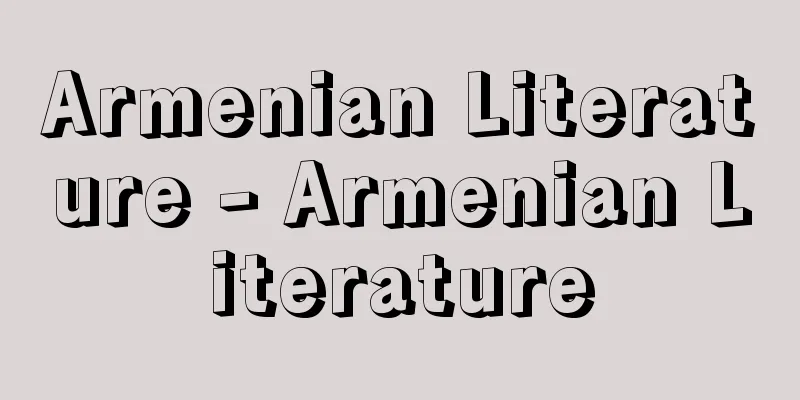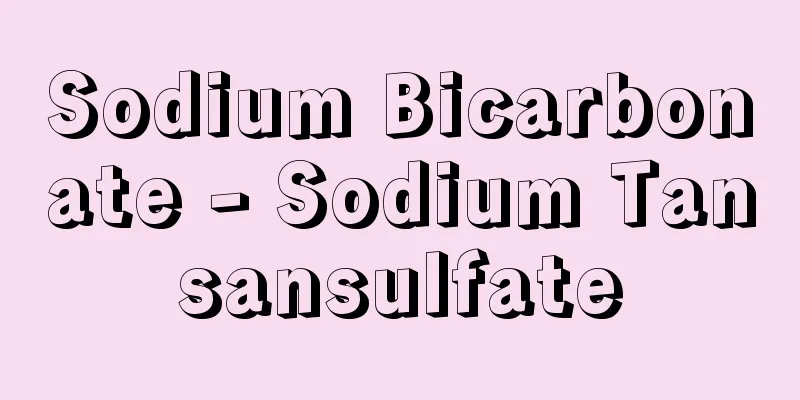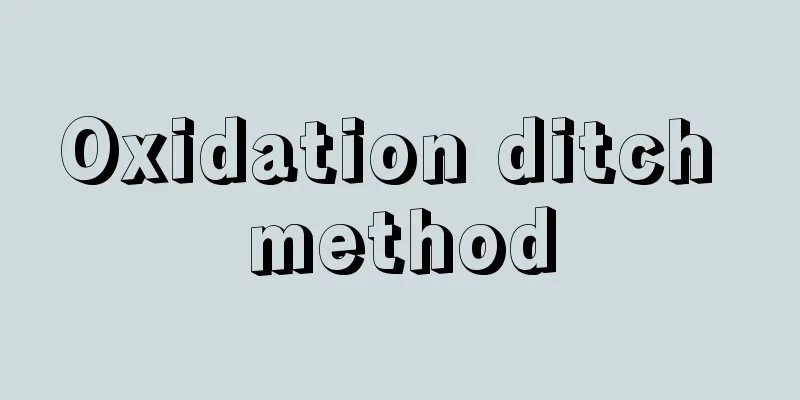Pigment - Ganryo (English spelling) pigment

|
A general term for colorants that are colored, opaque powders that are insoluble in water, oil, alcohol, etc. and that color things while remaining in a dispersed powder state. Those that are soluble in these are collectively called dyes, and pigments and dyes are collectively called colorants. Some dyes are insoluble and are used as pigments, and these are called color pigments. [Jun Otsuka] historySince prehistoric times, humans have crushed colored minerals and used them as pigments. Among them, certain types of soils containing iron oxide as the main component are believed to have been the most commonly used to produce yellow, brown, and red hues. Other known pigments include those shown in 1. Cinnabar was used in ancient China, and azurite in ancient Egypt, and a blue pigment called Egyptian blue with the composition CaCuSi 4 O 10 was already produced. Mitudaso (yellow), red lead (reddish-orange), white lead, and verdigris were also prepared. In addition to these, Italy produced verdigris, a green clay substance; sienna, which contains iron and has a dark khaki color; and umber, which contains manganese as well as iron and has a brown color; and natural ultramarine from Afghanistan was prized as a highly expensive pigment. In late medieval Germany, blue glass of the CoO-K 2 O-SiO 2 system was called smalt and was used. In the 18th century, with the rapid advancement of chemistry, new pigments were created one after another. The main ones are shown in 2. Furthermore, chromium, discovered in 1779, was a milestone in the history of pigments, as can be seen from the fact that it was named after the Greek word chromos, meaning color, due to the diversity of colors that its compounds can produce. Many of the inorganic pigments currently in practical use have been produced industrially since the 20th century. [Jun Otsuka] History of ceramic pigmentsIn the field of ceramics, various pigments have been created in conjunction with developments. The colorants for glazes that have been used since ancient times were compounds (mainly oxides) of iron, manganese, cobalt, and antimony. From the end of the 18th century to the beginning of the 19th century, keeping pace with the progress of modern chemistry, attempts were made to color ceramics with newly discovered compounds. Chromium oxide and zinc oxide, the most important raw materials for ceramic pigments, appeared during this period, and Victoria Green and Chrome Tin Pink, which can be said to be masterpieces of ceramic pigments, were created. In the 20th century, zircon pigments and opacifiers were developed. Zircon pigments come in blue, yellow, gray, salmon pink, and other colors that can be used in a variety of glazes. They can also be mixed to create intermediate colors of your choice, allowing a wide range of tile colors to be used. [Jun Otsuka] Classification and UseThere are so many types of pigments that it is difficult to include them all in a simple classification. Usually, pigments are broadly divided into natural pigments and synthetic pigments, and inorganic pigments and organic pigments, but it is more practical to classify them by color. This section mainly describes inorganic pigments. If we divide general inorganic pigments by color and function, we get the following. Classification by color White pigments = titanium dioxide, zinc oxide, zinc sulfide, lithopone, white lead, antimony White body pigments = precipitated barium sulfate, baryte powder, calcium carbonate, alumina white, white carbon, clay Black pigments = carbon black, iron black, chrome black, copper chromate Red pigments = red iron oxide, molybdenum red, cadmium red, red lead Orange pigments = molybdenum orange, cadmium orange, yellow lead (reddish red) [Jun Otsuka] natureRegardless of whether a pigment is inorganic or organic, the physical properties generally required for pigments are as follows: (1) Pigment particles Pigments, unlike dyes, are used with a certain shape, size, and particle size distribution. Even with the same chemical composition, the physical properties such as color, tinting power, hiding power, and oil absorption can vary greatly depending on the particle size and shape. The shape of the particles can be observed using a microscope or electron microscope. (2) Hiding power, transparency, and coloring power Hiding power is the ability of a paint to completely hide the base. It varies depending on the particle size even for the same pigment, and generally the smaller the particle, the greater the hiding power. However, when the particle size is less than half the wavelength of visible light (about 300 to 400 millimicrons), light passes through the pigment and it becomes transparent. Transparent iron oxide pigments, mainly α-Fe 2 O 3 and α-FeOOH, have a particle size of 100 millimicrons or less. Generally, high hiding power is desirable, but transparency is required for metallic paints. Hiding power and transparency are determined by the difference in refractive index between the pigment and the vehicle (binder). If this difference is large, the hiding power is high, and as the difference becomes small, it becomes gradually more transparent. Coloring power increases as the particle size becomes smaller. (3) Durability Durability includes lightfastness, weather resistance, heat resistance, chemical resistance, oil resistance, water resistance, etc. (a) Lightfastness Lightfastness tests are never performed on the pigment alone, but always on the pigment-vehicle system. Since exposure to sunlight takes several months or more than a year, accelerated testing is performed using a fade-ometer (a representative fading tester). (b) Weatherfastness It can be distinguished from lightfastness, but pigments with low lightfastness also have poor weatherfastness. Weather meters and salt spray testers are used for accelerated weatherfastness testing. (c) Heat resistance Inorganic pigments are stable from 100°C to over 1000°C, which is far superior to organic pigments that are stable at 300°C at most. (d) Chemical resistance Depending on the purpose of use, acid resistance, alkali resistance, or resistance to other chemicals is required. For example, alkali resistance is required for pigments for color cement or for painting on concrete. (e) Oil and solvent resistance: Necessary when used in plastics and paints. In the case of inorganic pigments, most pigments are insoluble in solvents, oils, and resins. (f) Water resistance: Most pigments are insoluble in water, but for special applications such as rust prevention or antifouling pigments, a small amount of dissolution of the pigment is effective. (4) Specific Gravity The specific gravity of inorganic pigments ranges from about 2 for Prussian blue and carbon black to about 9 for red lead, with most pigments falling between 3 and 6. The specific gravity of organic pigments is significantly lower than that of inorganic pigments, falling between about 1.2 and 2.9. In terms of bulk, organic pigments are usually larger than their specific gravity. (5) Reactivity and Hydrogen Ion Concentration (pH) Two or more pigments are often mixed to produce the desired color. For this reason, it is necessary to understand the properties of each pigment. In general, mixing a sulfide pigment with a pigment containing lead will result in a black color, and mixing a basic pigment such as lead white with an oil with a high acid value will result in a gel. (6) Oil absorption: The amount of oil that can be absorbed when all the voids between pigment particles are filled with the vehicle. The oil absorption is affected by the specific gravity of the pigment, its particle size and shape, surface condition, agglomeration state, and the type and viscosity of the vehicle. (7) Pigment surface treatment This is done to change the properties of the pigment surface and give it other or higher performance. Surface treatment improves dispersibility, wettability, durability, light resistance, weather resistance, heat resistance, chemical resistance, chalking resistance, moisture absorption, color stability, storage stability, coating gloss, hiding power, coloring power, oil absorption, etc., and also makes it possible to inactivate the pigment. Pigments are classified as hydrophilic and lipophilic, and their hydrophilicity and lipophilicity can be adjusted by surface treatment, or even reversed. The most common purpose of pigment surface treatment is to improve dispersibility or wettability, which improves workability and makes it possible to disperse pigments with little energy. The next most common purpose is to improve durability and weather resistance. In addition, surface treatments are used to prevent charging, oxidation, dusting, aggregation, and caking, and to improve corrosion resistance in the case of metal powder pigments. The most well-known example is titanium oxide, whose surface is coated with hydrous oxides of aluminum or silicon, or a small amount of zinc oxide is added during firing to improve dispersibility and weather resistance. Surface treatments such as those mentioned above change the physical properties of the pigment surface, and therefore naturally change the pigment's powder properties such as its aggregation state, specific surface area, electrostatic properties, adhesion, packing properties, and fluidity. For this reason, they can have both positive and negative effects in unit operations such as storage, transportation, mixing, and dust collection, so great care must be taken when actually handling pigments. As mentioned above, pigments are rarely used as a single type, but are often used in multi-component systems of two or more types, and surface treatment agents can cause unexpected problems. This shows that pigment surface treatments are not universal. (8) Pigment dispersion The quality of pigment dispersion determines the color, gloss, hiding power and other physical properties of paints, printing inks, plastics, paints, etc. In addition to advances in dispersion equipment, surface treatments, and the use of surfactants and other auxiliaries have greatly contributed to pigment dispersion. [Jun Otsuka] New trends in inorganic pigmentsInorganic pigments are used for a wide range of purposes, including not only coloring objects, but also rust prevention, antifouling (mainly ship bottom paint), fluorescent pigments (luminous paint), ceramics, and temperature indication. Recently, the use of white carbon as a filler in adhesives to improve adhesion and to add it to paper as a pigment and filler to reduce its weight have been considered. In addition, pigments that absorb visible light and are used to coat the phosphors of television cathode ray tubes to create color contrast include red iron oxide (which absorbs blue and green parts to create red contrast) and cobalt blue (which absorbs green and part of red to create blue contrast). In addition, camouflage pigments that reflect infrared light in the same way as the surroundings and hide their presence in infrared photographs have been developed. The conditions under which general inorganic pigments are used are gradually becoming harsher, and as a result, there are a few examples of ceramic pigments, which are heat-resistant and durable, being used in the field of general inorganic pigments. [Jun Otsuka] "New Science of Industrial Materials" edited by Chihiro Kawashima (1968, Kanehara Publishing) " ▽ "Pigments and Paints" by Toshihide Kuwahara and Norio Ando (1982, Kyoritsu Publishing) [Reference] | |©Shogakukan "> Ancient natural pigments and medieval synthetic pigments [Table 1,... Source: Shogakukan Encyclopedia Nipponica About Encyclopedia Nipponica Information | Legend |
|
水、油、アルコールなどに不溶の有色不透明の粉末で、粉末の分散状態のままで物を着色する色料の総称。これらに可溶なものは染料と総称し、顔料と染料をあわせて色素という。染料のなかにも不溶のものがあり、顔料として用いられ、これらは色素顔料とよばれる。 [大塚 淳] 歴史有史以前より人類は有色の鉱物を粉砕し、顔料として使用している。そのなかでも酸化鉄を主成分とするある種の土は、黄、茶、赤系の色調を示すものとして、もっともよく使用されていたと推定される。このほかにも1のようなものが知られていた。 古代中国では辰砂(しんしゃ)が、古代エジプトでは藍銅(らんどう)鉱が使用され、さらにエジプト青とよばれるCaCuSi4O10の組成をもつ青色顔料がすでにつくられていた。また、密陀僧(みつだそう)(黄色)、鉛丹(えんたん)(赤橙(せきとう)色)、鉛白、緑青(ろくしょう)も調製されていた。これらのほかイタリアでは、緑色の粘土物質である緑土、鉄を含み暗いカーキ色を示すシェナ、鉄のほかにマンガンなどを含み茶色を示すアンバーを産し、アフガニスタン産の天然群青(ぐんじょう)は高価な顔料として珍重された。 中世後期のドイツではCoO-K2O-SiO2系の青色ガラスがスマルトとよばれ使用された。18世紀に入り、化学の急速な進歩とともに新しい顔料が次々につくられた。おもなものを2に示す。また、1779年に発見されたクロムは、その化合物がもつ色の多様性から、色を意味するギリシア語のchromosにちなんで命名されたことからもわかるように、顔料史上の画期をなしたともいえるものである。現在実用化されている無機顔料の多くは、20世紀になって工業的な生産に移行されている。 [大塚 淳] セラミック顔料の歴史陶磁器の分野でも、その開発に伴っていろいろな顔料がつくられてきた。古くから使われていた釉(ゆう)(うわぐすり)の着色剤は、鉄、マンガン、コバルトおよびアンチモンの化合物(主として酸化物)であった。18世紀末から19世紀初期にかけ、近代化学の進歩に歩調をあわせ、新しく発見された化合物による陶磁器の着色が試みられた。セラミック(陶磁器)顔料の原料としてもっとも重要な酸化クロム、酸化亜鉛がこの時期に登場し、セラミック顔料の傑作ともいうべきビクトリアグリーンとクロムスズピンクとがつくられている。 20世紀になり、ジルコン系の顔料および乳濁剤が開発された。ジルコン系顔料には、青、黄、グレー、サーモンピンクなどがあり、各種の釉に使用でき、混色が可能なため、好みの中間色が出せるようになり、タイル類の色調が豊富になった。 [大塚 淳] 分類と用途顔料の種類は非常に多く、簡単な分類ですべてを包含することはむずかしい。普通、天然顔料と合成顔料、無機顔料と有機顔料に大別されるが、色別による分類のほうが実際的である。この項では主として無機顔料について述べる。一般の無機顔料を色別および機能別に分けてみると次のようになる。 色による分類 [大塚 淳] 性質無機顔料、有機顔料の別を問わず、顔料一般に要求される物性などは次のようなものである。 (1)顔料の粒子 顔料は染料と異なり、ある形状と大きさ、ある粒度分布をもった状態で使用する。同じ化学組成でも粒子の大きさ、形状により、色、着色力、隠蔽(いんぺい)力、吸油量などの物性は大きく変化する。粒子の形状は顕微鏡あるいは電子顕微鏡により観察できる。 (2)隠蔽力・透明性・着色力 塗料が下地を完全に隠蔽しうる能力を隠蔽力という。同じ顔料でも粒度により異なり、一般には粒子が小さいほど隠蔽力は大きくなる。しかし粒径が可視光線の波長の半分(約300~400ミリミクロン)以下になると、光は顔料を透過するようになり透明になる。α-Fe2O3やα-FeOOHを主体とする透明酸化鉄顔料では100ミリミクロン以下の粒径である。隠蔽力は一般には大きいことが望まれるが、メタリック塗料では透明性が要求される。隠蔽力、透明性は、顔料とビヒクル(展色材)の屈折率の差により決定される。この差が大きいと隠蔽力は大となり、差が小となるにつれ、しだいに透明になる。着色力は粒子が小さいほど増加する。 (3)耐久性 耐久性には、耐光性、耐候性、耐熱性、耐薬品性、耐油性、耐水性などがある。(a)耐光性 耐光性試験は顔料単独では行わず、かならず顔料‐ビヒクル系で行われる。日光暴露は数か月ないし1年以上を要するため、フェードオメーター(退色試験機の代表的なもの)により促進試験が行われる。(b)耐候性 耐光性と区別できるが、耐光性の低いものは耐候性も不良である。耐候性の促進試験にウェザーメーターや塩水噴霧試験機が用いられる。(c)耐熱性 無機顔料では100℃から1000℃以上まで安定というものまであり、有機顔料のせいぜい300℃という値に比べはるかに優れている。(d)耐薬品性 使用目的によって、耐酸性、耐アルカリ性、あるいは他の薬品に対する耐性が要求される。たとえば、カラーセメント用やコンクリートに塗る顔料では耐アルカリ性が必要である。(e)耐油性・耐溶剤性 プラスチックや塗料に使用するときに必要で、無機顔料の場合、ほとんどの顔料は溶剤、油、樹脂に不溶である。(f)耐水性 ほとんどの顔料は水に不溶であるが、さび止めあるいは防汚顔料など特殊な用途のものでは、顔料がわずか溶解することにより、効果が生じる。 (4)比重 無機顔料の比重は、紺青(こんじょう)、カーボンブラックの約2から鉛丹の約9まであり、大部分のものは3~6の間にある。有機顔料は無機顔料に比べ比重は著しく低く、約1.2~2.9の間にある。かさは通常、比重とは逆に、有機顔料が大である。 (5)反応性と水素イオン濃度(pH) 希望の色調を出すために、2種類以上の顔料を混合することがつねに行われている。このため、各顔料の性質を理解しておくことが必要である。一般に硫化物系の顔料と鉛を含む顔料とを混合すると黒変し、鉛白のような塩基性顔料に酸価の高い油を混ぜるとゲル化する。 (6)吸油量 顔料粒子間のすべての空隙(くうげき)をビヒクルで埋めたときのその量をさす。吸油量は、顔料の比重、粒径とその形状、表面の状態、凝集状態、およびビヒクルの種類と粘度により左右される。 (7)顔料の表面処理 顔料表面の性質を変え、他の性能あるいはさらに高度の性能を与えるため行う。表面処理により、分散性、湿潤性、耐久性、耐光性、耐候性、耐熱性、耐薬品性、耐白亜化性、吸湿性、色の安定性、貯蔵安定性、塗膜光沢、隠蔽力、着色力、吸油量などが改善され、また顔料の不活性化が可能になる。顔料には親水性のものと親油性のものがあり、表面処理により、その親水性、親油性を調節でき、さらにまったく逆の性質にすることもできる。顔料の表面処理は分散性または湿潤性の改善を目的とするケースがもっとも多く、この結果、作業性が向上、わずかのエネルギーで顔料を分散させることが可能となる。次に多いのが耐久性、耐候性などの向上を目的としたものである。このほか、帯電、酸化、粉塵(ふんじん)化、凝集、固結の各防止、金属粉末顔料では耐食性の向上など、いろいろの目的にあわせた表面処理が実用化されている。もっともよく知られている例が酸化チタンの場合で、アルミニウムやケイ素の含水酸化物で表面を被覆したり、焼成時に少量の酸化亜鉛を加え、分散性や耐候性の改善が図られている。 以上のような表面処理は、顔料の表面の物性を変化させることであり、したがって顔料の凝集状態、比表面積、静電特性、付着性、充填特性、流動性などの粉体としての特性も当然変化する。このため貯蔵、輸送、混合、集塵などの単位操作においては、プラスにもマイナスにも作用することがあるため、実際に顔料を取り扱うときは十分注意しなければならない。前述のように、顔料は1種類のみで使用されることは少なく、2種以上の多成分系で使用されることが多く、表面処理剤から予期せぬトラブルをおこすことがある。このことから顔料の表面処理に普遍性のないことがわかる。 (8)顔料の分散 顔料の分散状態の良否は、塗料、印刷インキ、プラスチック、絵の具その他の、色、光沢、隠蔽力その他の物性を左右する。顔料の分散は、分散装置の進歩のほか、表面処理、界面活性剤その他助剤の利用が大きく寄与している。 [大塚 淳] 無機顔料にみられる新しい流れ無機顔料の用途は、単に物を着色する以外に、防錆(ぼうせい)用、防汚用(主として船底塗料)、蛍光顔料(夜光塗料)、陶磁器用、示温用など多岐にわたっているが、最近、ホワイトカーボンを充填剤として接着剤に用いてその接着効果を向上させ、また、顔料、充填剤として紙に加えてその軽量化を図ることが検討されている。また、可視部の吸収を利用し、テレビのブラウン管の蛍光体に顔料をコートし、色調のコントラストをつける目的で用いられるものに、べんがら(青、緑の部分を吸収し赤のコントラストをつける)、コバルトブルー(緑から赤の一部を吸収し、青のコントラストをつける)などがある。このほか、周囲と同じように赤外線を反射し、赤外線写真からその存在を隠すカムフラージュ用の顔料も開発されている。一般の無機顔料の使用条件は、しだいに過酷になりつつあり、そのため、耐熱性、耐久性のよいセラミック顔料が一般の無機顔料の分野で使用される例が二、三出てきている。 [大塚 淳] 『河嶋千尋編『新しい工業材料の科学』(1968・金原出版)』▽『桑原利秀・安藤徳夫著『顔料および絵具』(1982・共立出版)』 [参照項目] | |©Shogakukan"> 古代の天然顔料と中世の合成顔料〔表1、… 出典 小学館 日本大百科全書(ニッポニカ)日本大百科全書(ニッポニカ)について 情報 | 凡例 |
Recommend
Goblin (English spelling)
1. A goblin that appears in European legends. 2 (G...
Threadfin tuna - Threadfin tuna
A marine fish of the order Perciformes, family Ca...
"Collection of Essays on Italian Medieval History" - Italian History
...This work has been revised by the Italian Hist...
Responsive Passion - Oushou Fujunankyoku
…Leonhard Lechner's (c. 1553-1606) four-part ...
Ainsworth, GC (English spelling) AinsworthGC
…By this time, mycology had become an independent...
Counterculture - counterculture
Counterculture. A general term for anti-authority...
Grenville, George
Born: October 14, 1712. Died November 13, 1770, Lo...
Jingu Zoureishu - Jingu Zoureishu
This is a compilation of the history of Ise Shrine...
Compression Ridge - Ashukuone
…A small ridge, measuring a few tens of meters in...
Kuginukimon - Kuginukimon
A simple gate with two bars at the top of the gate...
Unjo-kata
〘Noun〙 A subdivision of the accounting department ...
Birth bath - Ubuyu
This is the bath water given to newborn babies. V...
Theme - Thema (English) theme English
Theme. In music, it refers to the central idea of...
Geta - Japanese wooden clogs
A type of footwear. A strap is attached to a wood...
Niya - Niya (English spelling)
The remains of an ancient settlement on the south...









